Все способы:
- Способ 1: Приложение «Параметры»
- Способ 2: «Диспетчер устройств»
- Способ 3: Официальный сайт производителя
- Способ 4: Программы для обновления драйверов
- Вопросы и ответы: 0
Рассматриваемые в этой статье методы актуальны как для проверки недостающих драйверов, так и версий обновленных. С их помощью вы можете отследить, что было установлено автоматически, а какие компоненты все еще нуждаются в последней версии программного обеспечения. Ознакомьтесь с каждым вариантом и используйте подходящие для себя инструкции в зависимости от поставленной цели.
Способ 1: Приложение «Параметры»
В стандартном приложении «Параметры» есть раздел, через который осуществляется управление всеми системными обновлениями. В нем вы узнаете информацию о найденных или уже установленных апдейтах драйверов, но только в том случае, если они были обнаружены непосредственно встроенным в Windows средством.
- Для открытия необходимого меню через «Пуск» перейдите в «Параметры», щелкнув по шестеренке на панели слева.
- Выберите раздел «Обновление и безопасность».
- Если возможно сканирование, запустите его и дождитесь появления информации о найденных обновлениях или исправлениях. Среди списка со всеми нововведениями будут и найденные драйверы, которые сразу же можно инсталлировать.
- Дополнительно обратите внимание на блок «Доступно необязательное исправление», если он отображается в данном меню. В нем щелкните по надписи «Просмотреть все необязательные обновления».
- Разверните группу «Обновления драйверов».
- Посмотрите, какие компоненты доступны, и решите, хотите ли вы что-то из этого устанавливать в операционную систему.
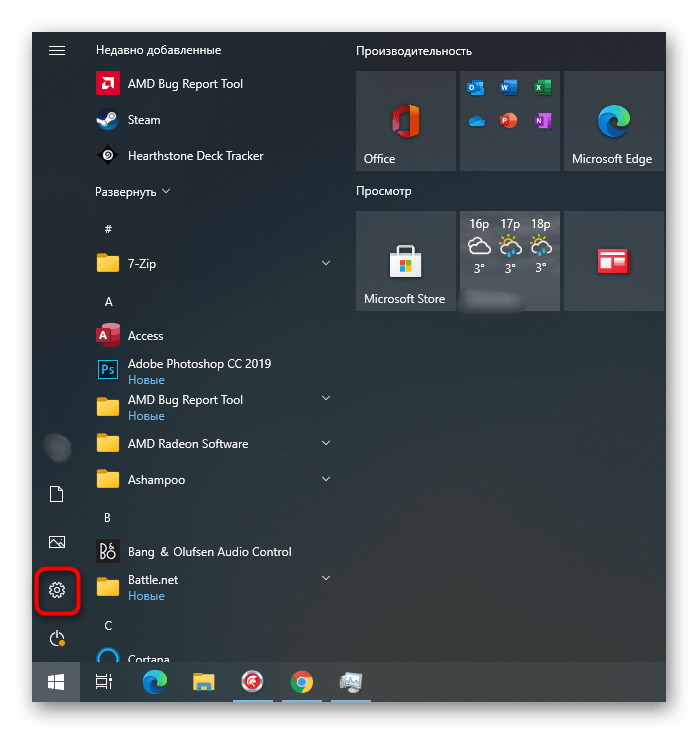

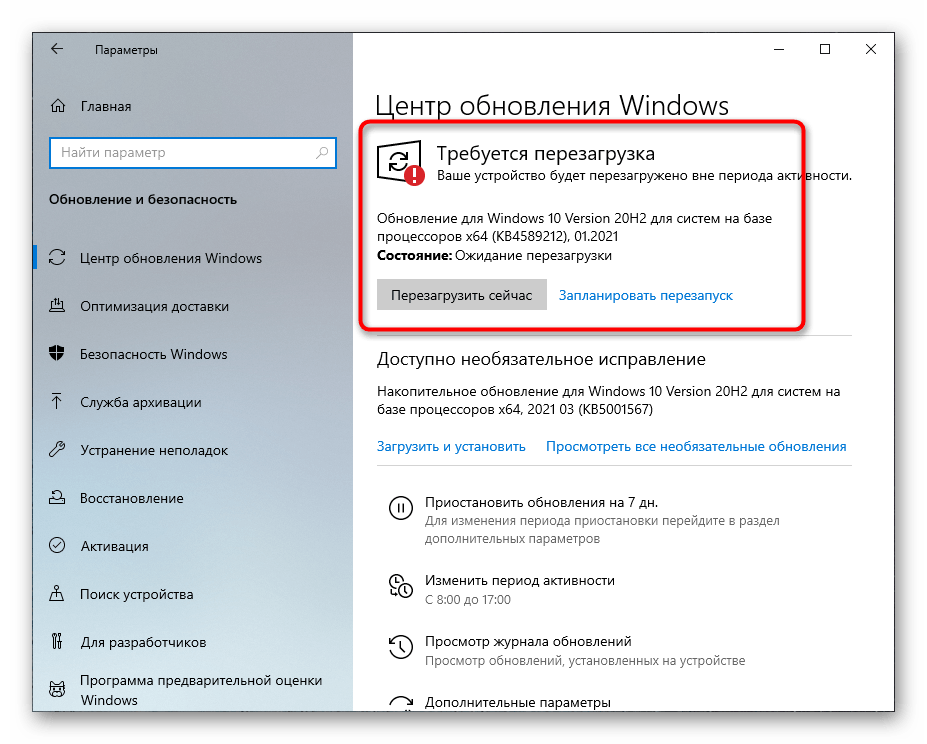

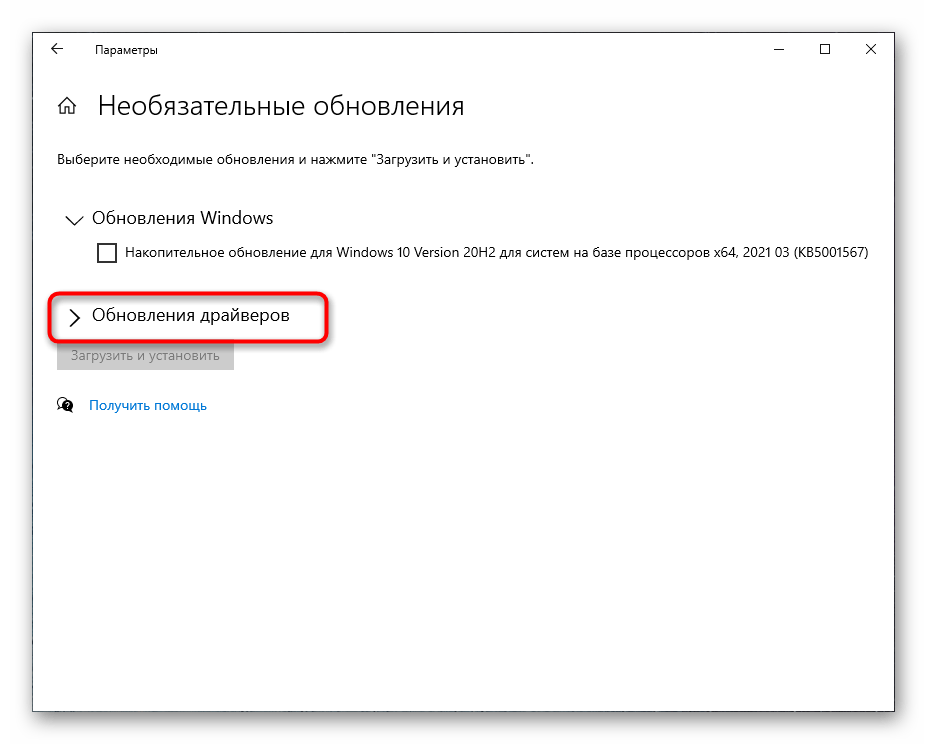
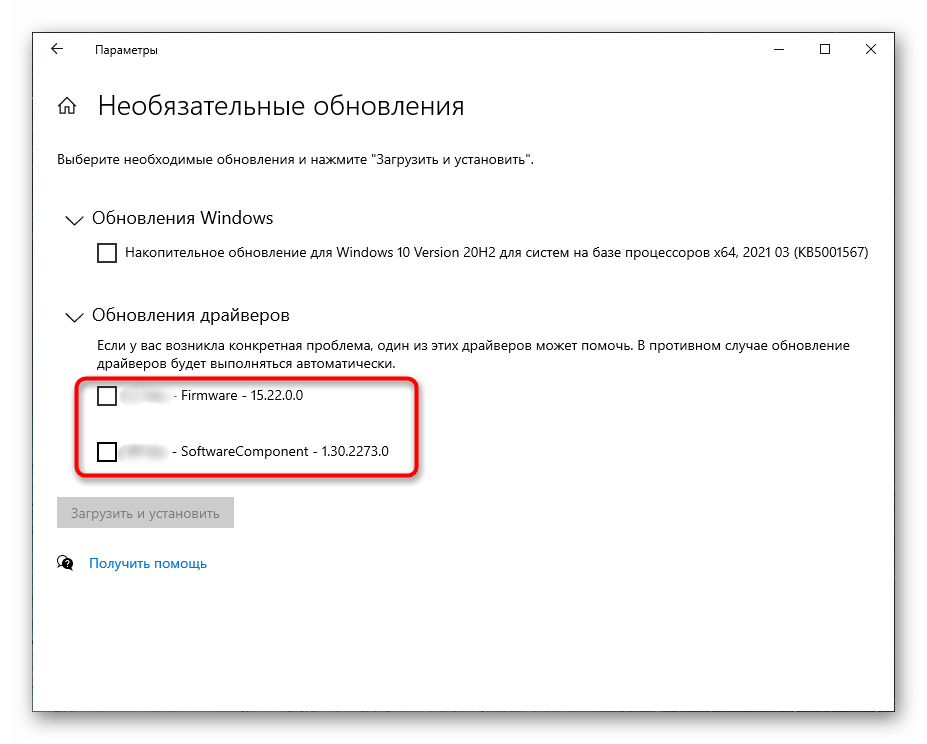
Как уже понятно, это руководство подходит для просмотра найденных, но еще не установленных драйверов. Если же вы хотите узнать, какие из них уже были добавлены стандартным средством Windows 10, не покидайте данное меню и выполните следующие действия:
- Найдите строку «Просмотр журнала обновлений» и нажмите по ней.
- В появившемся списке отыщите и разверните категорию «Обновления драйверов».
- Отобразятся все установленные драйверы, их наименования и версии. Ниже находится дата инсталляции, что поможет восстановить хронологию.



Способ 2: «Диспетчер устройств»
Если вы хотите не только узнать, есть ли обновления для драйверов, но и сразу установить их, не используя при этом дополнительные средства, может пригодиться «Диспетчер устройств». В этом стандартном приложении есть инструмент, выполняющий автоматический поиск обновлений через интернет.
- Щелкните правой кнопкой мыши по «Пуску» и из появившегося контекстного меню выберите пункт «Диспетчер устройств».
- Разверните категорию со всеми типами устройств, чтобы найти конкретное.
- Нажмите по оборудованию правой кнопкой мыши и выберите «Обновить драйвер». Если же вместо этого перейти в «Свойства», в новом окне можно увидеть текущую версию драйвера.
- Запустите автоматический поиск драйверов — компьютер должен быть подключенным к интернету.
- Установка начнется сразу же после успешного поиска, учитывайте это при выполнении операции.
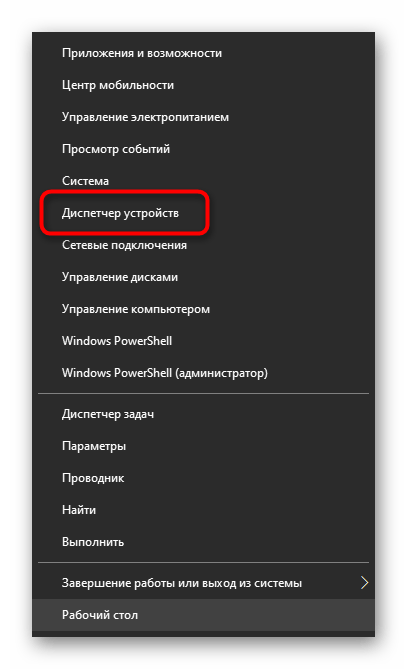

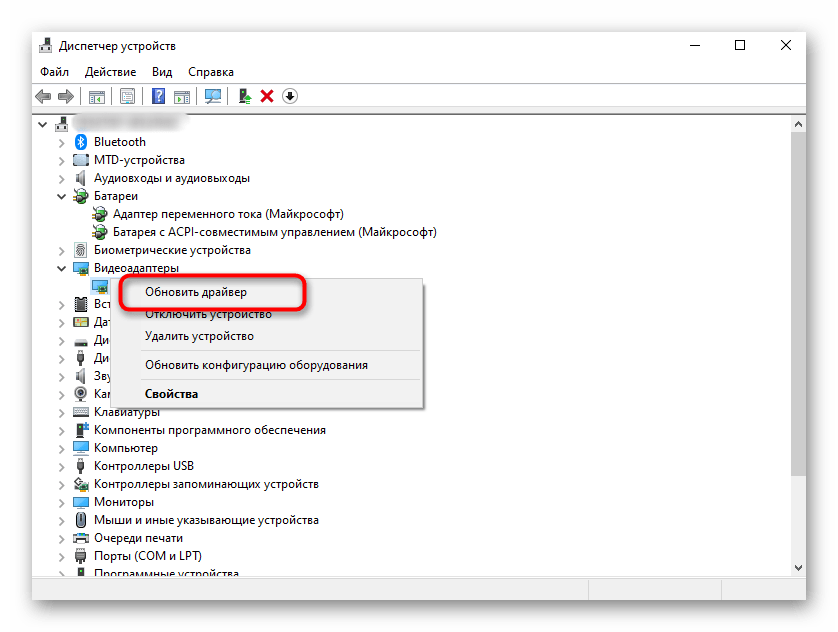

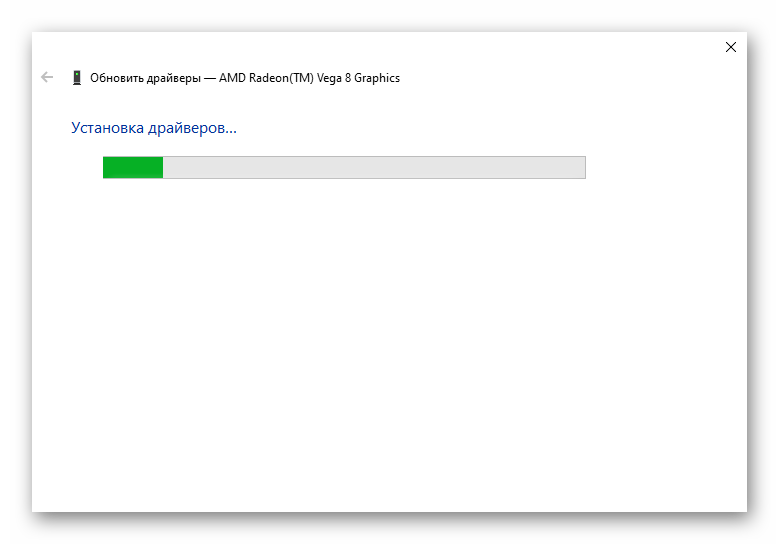
Если обновлений найдено не было, в новом окне появится соответствующее сообщение. Однако это еще не значит, что их действительно нет — во многих случаях встроенное средство не может отыскать их в своей официальной библиотеке. При этом на сайте разработчика устройства вполне могут быть последние версии драйверов, доступные для загрузки.
Способ 3: Официальный сайт производителя
В этом методе поговорим об использовании официального сайта производителя материнской платы, ноутбука или конкретного комплектующего для поиска обновлений драйверов. Соответственно, сейчас нужно узнать текущую версию, чтобы сравнить ее и установить. Проще всего это сделать через системную утилиту.
- Откройте окно «Выполнить», используя для этого горячую клавишу Win + R. Введите там
msinfo32и нажмите Enter для подтверждения ввода команды. - В списке с компонентами отыщите тот, в обновлении драйвера которого вы заинтересованы.
- Выберите его и ознакомьтесь со сведениями в блоке справа. Сейчас вас интересует строка «Версия драйвера».


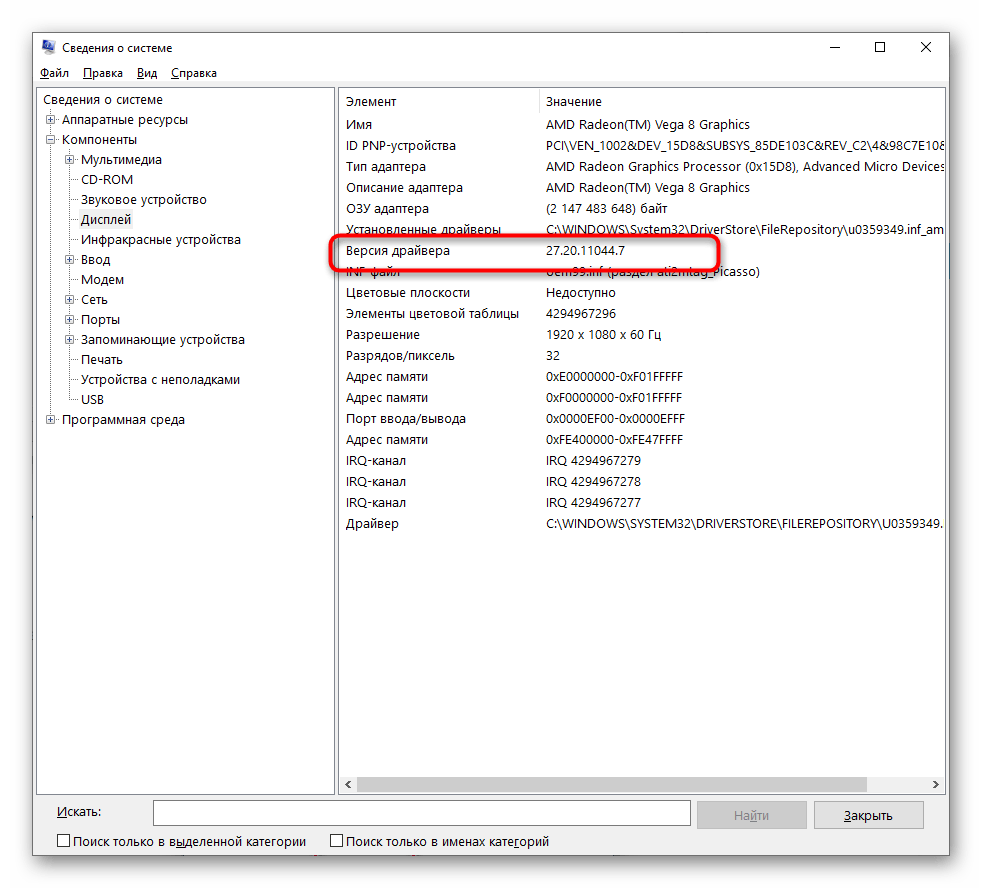
При желании можете получить такие же сведения через «Диспетчер устройств», о чем уже было сказано ранее, или при помощи специального софта от сторонних разработчиков, предоставляющего информацию о комплектующих. Список подходящих программ есть в статье по ссылке ниже.
Подробнее: Программы для определения железа компьютера
Теперь, когда текущая версия установленного драйвера обнаружена, остается узнать о последней выпущенной, отыскав ее на официальном сайте разработчика оборудования. Разберем этот алгоритм действий на примере материнской платы от ASUS.
- Перейдите на официальный сайт по прямой ссылке, введите запрос в поисковике или откройте сразу страницу модели лэптопа, материнской платы или другого комплектующего, указав ее в поиске.
- Зайдите в раздел «Техподдержка» (на сайтах компаний он называется по-разному, например, «Загрузки» или «Документация и файлы»).
- Разверните список драйверов и выберите версию используемой операционной системы.
- Найдите последнюю версию драйвера и сравните ее с установленной.
- Можно сразу же скачать и обновить программное обеспечение комплектующего, если хотите сделать это прямо сейчас. Обычно разработчики предоставляют установщик в виде EXE-файла, который следует запустить и выполнить появившиеся на экране инструкции.
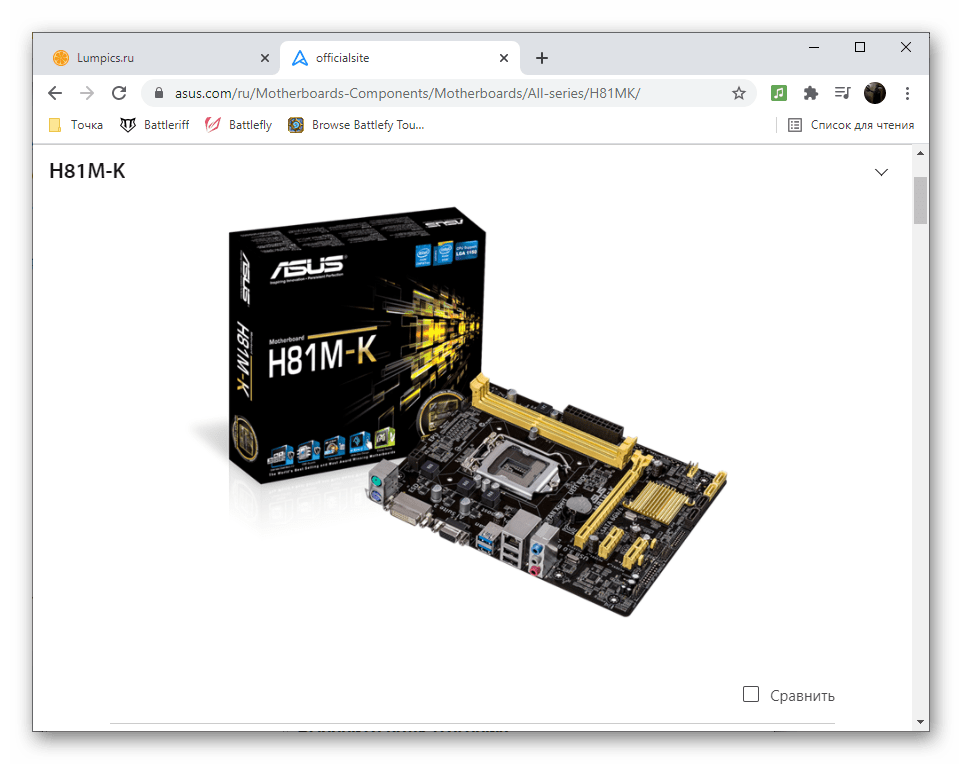
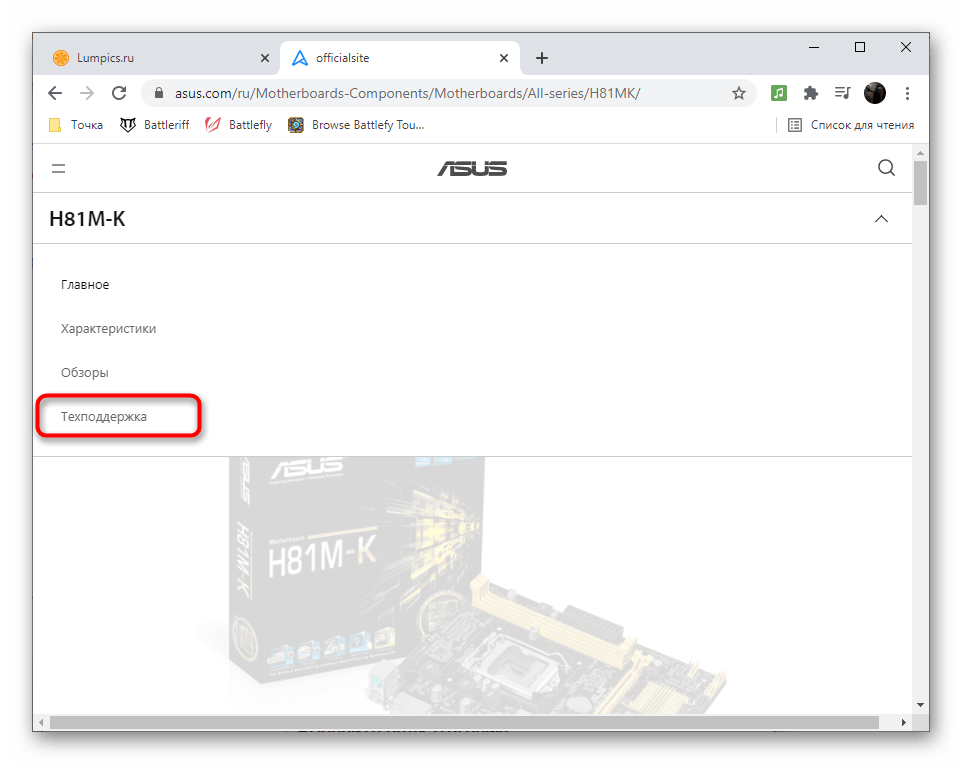

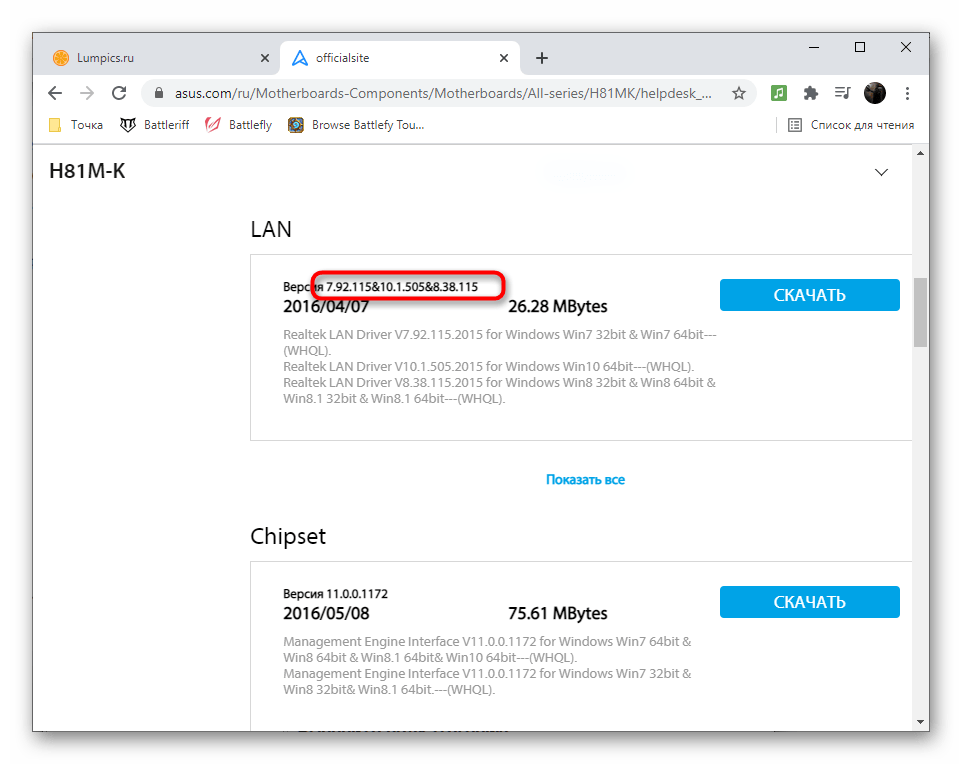

Способ 4: Программы для обновления драйверов
Не обязательно сразу же устанавливать драйверы, найденные соответствующей программой от сторонних разработчиков. Ничего не мешает просто посмотреть версию и использовать данную информацию для личных целей. Однако иногда такой софт оказывает полезным и позволяет инсталлировать драйверы, которые уже отсутствуют на официальном сайте. Прямое предназначение подобных приложений — обновление ПО всего оборудования, установка фирменных утилит от производителя ноутбука или отдельных компонентов ПК.
Подробнее: Программы для обновления драйверов на ПК

Наша группа в TelegramПолезные советы и помощь
Want to ensure your Windows 10 drivers are up-to-date and functioning correctly? This brief guide will show you how to check drivers in Windows 10 in just a few easy steps. Whether you’re troubleshooting a problem or just doing some routine maintenance, you’ll find this process straightforward and quick.
In this section, we’ll walk you through the steps to check and verify the status of your drivers on a Windows 10 system. This will help you identify if any drivers need updating or troubleshooting.
Step 1: Open Device Manager
Press the Windows key and type «Device Manager,» then press Enter.
Device Manager is the hub for all your hardware components. It lists everything connected to your computer and will show you if any devices are having driver issues.
Step 2: Locate the Device
In Device Manager, find the device category you want to check and click the arrow to expand it.
This could be anything from «Display adapters» to «Sound, video and game controllers.» Expanding the category will show you all the devices listed under it.
Step 3: Right-Click the Device
Right-click the specific device you want to check and select «Properties.»
The Properties window will give you detailed information about the device, including its current driver status and version.
Step 4: Check the Driver Tab
Within the Properties window, click the «Driver» tab.
Here, you’ll find all the information you need about the driver, including its version, date, and provider. You can also update or roll back the driver from this tab.
Step 5: Update the Driver
If the driver is outdated or causing issues, click «Update Driver» to search for updates.
Windows will either search automatically for updated driver software or let you browse your computer for driver software.
After completing these steps, Windows 10 will either confirm that your driver is up-to-date or install the latest version. If you opted to browse for a driver, you might need to download the latest one from the manufacturer’s website first.
Tips for Checking Drivers in Windows 10
- Regular Checks: Make it a habit to check your drivers every few months.
- Automatic Updates: Enable automatic driver updates to save time.
- Use Manufacturer Websites: For the most reliable drivers, download directly from the hardware manufacturer’s website.
- Backup Drivers: Before updating, create a backup of your current drivers in case something goes wrong.
- Use Driver Update Software: Consider using third-party software to automate the process for you.
Frequently Asked Questions
What is a driver in Windows 10?
A driver is a piece of software that allows your computer to communicate with hardware devices.
Why should I update my drivers?
Updating drivers can improve system performance and fix bugs or compatibility issues.
How often should I check for driver updates?
It’s a good practice to check for updates every few months or when you experience hardware issues.
Can outdated drivers cause problems?
Yes, outdated drivers can cause hardware malfunctions, system instability, and performance issues.
How do I know if a driver is causing a problem?
Device Manager will typically display a yellow triangle next to the problematic device, indicating an issue.
Summary
- Open Device Manager.
- Locate the Device.
- Right-Click the Device.
- Check the Driver Tab.
- Update the Driver.
Conclusion
Knowing how to check drivers in Windows 10 is an essential skill for maintaining the health of your computer. By following the steps laid out in this guide, you can ensure your system runs smoothly and efficiently. Keeping your drivers up-to-date not only improves performance but also helps in avoiding potential hardware issues.
Don’t overlook the importance of regular driver maintenance. Next time you encounter a hardware problem, consider checking the driver status before diving into more complicated troubleshooting. Think of it as a routine check-up; just as you wouldn’t ignore your car’s maintenance, don’t ignore your computer’s drivers.
For further reading, you might explore topics like «how to troubleshoot hardware issues» or «best driver update tools.» Taking the time to educate yourself on these subjects will make your computer ownership experience much more enjoyable. Happy computing!
Matt Jacobs has been working as an IT consultant for small businesses since receiving his Master’s degree in 2003. While he still does some consulting work, his primary focus now is on creating technology support content for SupportYourTech.com.
His work can be found on many websites and focuses on topics such as Microsoft Office, Apple devices, Android devices, Photoshop, and more.
Значительная часть сбоев Windows, завершающаяся синим экраном бывает вызвана неправильной работой какого-то из драйверов. Какой именно драйвер вызвал синий экран обычно можно выяснить путем анализа дампа памяти, при условии, что он сохранен. Если это не так, или синий экран сложно отловить, помочь может встроенный диспетчер проверки драйверов Windows.
В этой инструкции о том, как использовать Driver Verifier для проверки драйверов и поиска драйвера, который вызывает сбой в Windows 11, Windows 10 и других версиях системы.
Запуск Driver Verifier и настройка проверки драйверов
Диспетчер проверки драйверов — встроенный инструмент Windows, в общем случае порядок использования которого состоит из следующих шагов:
- Перед тем как приступать, рекомендуется создать точку восстановления системы, также имеет смысл добавить безопасный режим в меню загрузки Windows (пример действий описан в инструкции Безопасный режим Windows 11, но подойдет и для предыдущих версий системы), а также убедиться, что сохранение дампов памяти включено, подробнее: Как включить сохранение дампов памяти в Windows при сбоях.
- Нажмите клавиши Win+R на клавиатуре, введите verifier и нажмите Enter.
- Будет запущен диспетчер проверки драйверов. На первом экране вы можете задать какие параметры использовать при проверке драйверов, обычно достаточно использовать опцию «Стандартные параметры». При использовании опции «Создать нестандартные параметры» вы сможете вручную установить, какие именно тесты будут проводиться и включить дополнительные тесты в дополнение к стандартным.
- Следующий этап — выбор какие драйверы следует проверить: можно выбрать только неподписанные драйверы, только для старых версий Windows, тестировать все драйверы или конкретный файл драйвера. В контексте этой инструкции выбираем «Автоматически выбирать все драйверы, установленные на этом компьютере».
- Вам будет предложено перезапустить компьютер — выполните перезагрузку.
- Также вы можете включить средство проверки драйверов для конкретного драйвера в командной строке, запущенной от имени администратора, например, команда для проверки всех драйверов в стандартном режиме выглядит следующим образом:
verifier /standard /all
а команда для проверки выбранных файлов драйверов имеет следующий синтаксис:
verifier /standard /driver driver1.sys driver2.sys
После перезагрузки драйверы будут тестироваться в фоновом режиме всё время, пока вы работаете с ОС. Каких-либо отчетов об этом не появится (но базовую информацию можно посмотреть в диспетчере проверки драйверов в пункте «Вывести сведения о текущих проверенных драйверах»), задача — проверить, при каких тестах и какой драйвер вызывает сбой.

При сбое какого-то из драйверов в ходе теста вы получите синий экран, обычно с одним из следующих кодов:
DRIVER_VERIFIER_DETECTED_VIOLATION DRIVER_CAUGHT_MODIFIYING_FREED_POOL DRIVER_VERIFIER_IOMANAGER_VIOLATION DRIVER_VERIFIER_DMA_VIOLATION SPECIAL_POOL_DETECTED_MEMORY_CORRUPTION
Возможны и иные варианты кодов ошибки. После таких сбоев вы можете использовать специальные средства для анализа дампов памяти, например, WinDbg (который поддерживает помимо стандартных команд анализа дампа, сбор статистики от Driver Verifier с помощью команды !verifier), чтобы выяснить, какой именно драйвер вызвал синий экран. Примечание: если из-за синих экранов не получается выполнять какие-либо действия на компьютере, используйте безопасный режим и отключение проверки драйверов с помощью Driver Verifier, о чем подробнее далее.
Кстати, если синие экраны с кодами DRIVER_VERIFIER появляются у вас без описанных действий, вероятно, диспетчер проверки драйверов был запущен вами (либо кем-то еще) когда-то ранее и в дальнейшем проверка не отключалась.
Проверить текущий статус проверки драйверов можно с помощью команды verifier /query в командной строке. При запущенной проверке вам будет предоставлен отчет о проверяемых драйверах, в случае остановленной проверки или если она не запускалась, вы увидите сообщение «No drivers are currently verified».
Остановка проверки драйверов в Driver Verifier
Проверка драйверов будет производиться до тех пор, пока вы не отключите её вручную: автоматически она не остановится ни после перезагрузки, ни после завершения работы.
Чтобы остановить диспетчер проверки драйверов и прекратить стресс-тесты драйверов, используйте один из способов:
- Запустить диспетчер проверки и использовать опцию «Удалить существующие параметры».
- Использовать командную строку, запущенную от имени администратора и команду
verifier /reset
Проверка драйверов прекратится после выполнения одного из указанных действий и перезагрузки компьютера.
Если по какой-то причине зайти в безопасный режим не удается, либо действия в нём невозможны, вы можете отключить диспетчер проверки драйверов одним из следующих способов:
- Использовать точку восстановления системы на дату, когда проверка еще не была запущена. Это можно сделать в том числе из среды восстановления или с загрузочной флешки Windows, выбрав пункт «Восстановление системы» на втором экране программы установки.
- Загрузить куст реестра SYSTEM и удалить разделы
HKEY_LOCAL_MACHINE\SYSTEM\CurrentControlSet\Control\Session Manager\Memory Management\VerifyDrivers
и
HKEY_LOCAL_MACHINE\SYSTEM\CurrentControlSet\Control\Session Manager\Memory Management\VerifyDriverLevel
Завершая, необходимо упомянуть вторую по частоте причину синих экранов — ошибки оперативной памяти. И для проверки RAM на ошибки в Windows тоже есть встроенный инструмент — Средство проверки памяти Windows.
When it comes to ensuring your Windows 10 computer is running smoothly, checking and updating drivers is vital. But did you know that outdated or incompatible drivers can not only cause performance issues but also make your system vulnerable to security threats? That’s why knowing how to check drivers in Windows 10 is crucial for every user.
To check drivers on Windows 10, you can utilize the Device Manager, a built-in utility that provides information about all the hardware components connected to your computer. By accessing the Device Manager, you can view a list of your devices and their corresponding drivers. Through this tool, you can identify outdated or malfunctioning drivers and take necessary steps to update or replace them. Keeping drivers up to date not only enhances system stability and performance but also ensures compatibility with the latest software and security patches.
In order to check drivers on Windows 10, follow these steps:
- Click on the Start menu and select «Device Manager.»
- Once the Device Manager window opens, you’ll see a list of all the hardware categories on your computer.
- Expand the category whose drivers you want to check.
- Right-click on the device and select «Properties.»
- In the Properties window, go to the «Driver» tab, where you’ll find information about the installed driver version and date.
By following these steps, you can easily check drivers on Windows 10.

Understanding the Importance of Checking Drivers in Windows 10
Keeping your drivers up to date is crucial for the smooth functioning of your Windows 10 operating system. Drivers are software programs that allow your computer’s hardware devices to communicate with the operating system and perform their designated tasks. Updating drivers ensures compatibility with the latest software and fixes any bugs or issues that may arise. In this article, we will explore various methods to check drivers in Windows 10 and ensure optimal system performance.
Using the Device Manager to Check Drivers
The Device Manager is a built-in Windows tool that allows you to view and manage all the hardware devices connected to your computer. It provides a comprehensive list of installed devices along with their corresponding drivers. Here’s how you can use the Device Manager to check and update your drivers:
- Open the Device Manager by right-clicking on the Start button and selecting «Device Manager» from the menu.
- In the Device Manager window, expand the categories to view the installed devices.
- Locate the device for which you want to check the driver. You can expand the category or use the search function to find it quickly.
- Right-click on the device and select «Properties» from the context menu.
- In the Properties window, go to the «Driver» tab.
- Here, you can see the driver details including the driver version, date, and provider. If there is a newer version available, you can choose to update the driver.
By following these steps, you can easily check the drivers for specific devices using the Device Manager. Keep in mind that this method may not cover all the devices in your system, especially peripherals that may have dedicated software.
Checking Drivers Using Manufacturer’s Websites
Another way to check drivers in Windows 10 is by visiting the official website of the device manufacturer. Many hardware manufacturers offer dedicated support pages where you can find the latest drivers for your specific device.
To check drivers using the manufacturer’s website:
- Identify the make and model of the device for which you want to check the driver.
- Visit the official website of the manufacturer.
- Navigate to the support or driver download section of the website. This may vary depending on the manufacturer’s website layout.
- Search for the device using the make and model information.
- Download the latest driver available for your device.
It’s important to note that while this method ensures you have the most up-to-date driver directly from the manufacturer, it can be time-consuming if you have multiple devices from different manufacturers.
Using Third-Party Driver Update Software
If you prefer a more automated approach to check drivers in Windows 10, you can use third-party driver update software. These applications scan your system, identify outdated drivers, and provide you with the option to update them with a single click.
There are several reputable driver update software available in the market, such as Driver Booster, Driver Easy, and Snappy Driver Installer. To check drivers using third-party software:
- Research and choose a trusted driver update software based on user reviews and ratings.
- Download and install the software on your computer.
- Launch the software and run a system scan.
- Once the scan is complete, the software will display a list of outdated drivers.
- Select the drivers you want to update and follow the software’s instructions to update them.
This method is convenient if you have multiple devices and want to streamline the driver update process. However, ensure you choose reliable software from trusted sources to avoid malware or compatibility issues.
Using Windows Update for Automatic Driver Updates
Windows 10 offers an automatic driver update feature through Windows Update. This feature enables your system to automatically download and install the latest drivers for your devices. Here’s how you can enable automatic driver updates:
- Go to the «Settings» app by clicking on the Start button and selecting the gear icon.
- In the Settings window, click on «Update & Security.»
- Select the «Windows Update» tab from the left sidebar.
- Click on the «Advanced options» link.
- Under the «Choose how updates are installed» section, toggle the «Automatically download drivers» option to the «On» position.
Enabling this option ensures that Windows Update will automatically download and install the latest drivers for your devices. However, it’s important to note that this method may not always provide the most up-to-date drivers, as some hardware manufacturers may release newer versions on their websites.
Verifying Driver Updates
Once you have checked and updated your drivers using the methods mentioned above, it’s important to verify that the updates were successfully installed. Here’s how you can do it:
- Open the Device Manager using the method mentioned earlier.
- Locate the device for which you updated the driver.
- Right-click on the device and select «Properties.»
- Go to the «Driver» tab and verify the driver version and date. It should match the updated driver version.
If the driver version matches, it means the update was successful. However, if the driver version remains the same, try reinstalling the driver or using alternative methods mentioned earlier to ensure the update takes effect.
Exploring Additional Methods to Check Drivers in Windows 10
In addition to the methods mentioned above, there are a few more ways to check drivers in Windows 10:
Using PowerShell Command
PowerShell is a powerful command-line tool in Windows that allows you to perform various administrative tasks. You can use PowerShell to check the drivers installed on your system by following these steps:
- Open PowerShell by right-clicking on the Start button and selecting «Windows PowerShell» or «Windows PowerShell (Admin)» from the menu.
- In the PowerShell window, type or paste the following command:
Get-WindowsDriver -Online
Press Enter to execute the command. PowerShell will display a list of all the drivers installed on your system, along with their provider, version, and date.
This method provides a comprehensive list of drivers and can be useful if you want to check all the drivers at once or perform advanced troubleshooting.
Using System Information Tool
The System Information tool in Windows 10 provides detailed information about your system, including hardware devices and their corresponding drivers. Here’s how you can check drivers using the System Information tool:
- Open the Run dialog by pressing the Windows key + R.
- Type «msinfo32» and press Enter to open the System Information tool.
- In the System Information window, expand the «Components» category from the left sidebar.
- Click on «Display» to view the drivers for your graphics card.
- Similarly, you can explore other categories under «Components» to check drivers for different hardware devices.
The System Information tool provides a user-friendly interface to view detailed information about drivers and other system components. However, it may not display all the drivers in your system, especially those for peripherals or third-party devices.
Using Driver Checkup Software
If you want a dedicated software solution to check drivers, you can use driver checkup software such as Driver Talent, DriverIdentifier, or Simple Driver Updater. These applications scan your system, identify outdated drivers, and provide you with recommendations to update them.
Similar to third-party driver update software, driver checkup software offers a streamlined approach to checking drivers and ensuring they are up to date. However, it’s crucial to choose reliable software from trusted sources to avoid potential security or compatibility issues.
Checking Windows Update History
If you have previously updated your drivers using Windows Update, you can check the update history to verify whether the driver updates were installed successfully. Here’s how:
- Go to the «Settings» app by clicking on the Start button and selecting the gear icon.
- In the Settings window, click on «Update & Security.»
- Select the «Windows Update» tab from the left sidebar.
- Click on the «View update history» link.
- Scroll through the list of installed updates and look for driver updates. If the updates are listed and indicate «Successful,» it means they were installed correctly.
Checking the update history can provide insight into the driver updates installed through Windows Update and help you ensure their successful installation.
Now that you are equipped with various methods to check drivers in Windows 10, you can regularly update your drivers to ensure optimal system performance and compatibility with the latest software. Remember to exercise caution when using third-party software and always refer to manufacturers’ websites for the most reliable and up-to-date drivers.

Checking Drivers in Windows 10
Keeping your drivers up to date is crucial for maintaining the performance and stability of your Windows 10 device. Here are two methods you can use to check for driver updates:
Method 1: Device Manager
The Device Manager provides an easy way to view and update drivers. To access it, right-click on the Start button and select Device Manager from the menu. In Device Manager, expand the categories to find the device whose driver you want to update. Right-click on the device and select Update Driver. Windows will automatically search for and install the latest driver for your device if it is available.
Method 2: Windows Update
Windows Update can also help you find and install the latest drivers for your hardware. To access Windows Update, go to Settings > Update & Security > Windows Update. Click on Check for updates to see if any driver updates are available. If updates are found, Windows will download and install them automatically.
Checking for driver updates regularly is recommended to ensure optimal performance and compatibility with your Windows 10 device. By following these methods, you can easily check and update your drivers.
Key Takeaways — How to Check Drivers Windows 10
- Check drivers by accessing the Device Manager in Windows 10.
- Access Device Manager by right-clicking on the Start button and selecting it from the menu.
- In Device Manager, expand the categories to see the list of drivers installed on your system.
- To check for driver updates, right-click on the driver and select «Update driver.»
- You can also use third-party software to check for driver updates automatically.
Frequently Asked Questions
In this section, we will provide answers to some commonly asked questions related to how to check drivers in Windows 10.
1. How can I check the drivers installed on my Windows 10 computer?
To check the drivers installed on your Windows 10 computer, you can follow these steps:
1. Press the Windows key + X on your keyboard and select «Device Manager» from the menu.
2. In the Device Manager window, expand the categories to find the device you want to check the driver for. Right-click on the device and select «Properties».
3. In the Properties window, go to the «Driver» tab. Here, you can find information about the driver version, date, and other details related to the selected device.
4. You can also click on the «Update Driver» button to check for any available updates for the selected device.
By following these steps, you can easily check the drivers installed on your Windows 10 computer.
2. How do I update drivers in Windows 10?
To update drivers in Windows 10, you can use the following method:
1. Press the Windows key + X on your keyboard and select «Device Manager» from the menu.
2. In the Device Manager window, expand the categories to find the device you want to update the driver for. Right-click on the device and select «Update Driver».
3. You can choose to search automatically for updated driver software, or you can browse your computer or the internet for the driver software.
4. Follow the on-screen instructions to complete the driver update process. If there are any available updates, Windows will download and install them.
Updating drivers in Windows 10 ensures that your devices are running with the latest features and fixes.
3. Can I check driver updates automatically in Windows 10?
Yes, you can set Windows 10 to check for driver updates automatically. Here’s how:
1. Press the Windows key + I on your keyboard to open the Settings app.
2. In the Settings app, click on «Update & Security».
3. In the Update & Security window, click on «Windows Update» in the left pane.
4. Click on «Advanced options» in the right pane.
5. Under the «Driver updates» section, toggle on the option that says «Automatically download drivers, and apps».
By enabling this option, Windows 10 will check for driver updates automatically and install them if available.
4. How do I roll back a driver in Windows 10?
If you are experiencing issues with a driver after updating it in Windows 10, you can roll back to the previous version using these steps:
1. Press the Windows key + X on your keyboard and select «Device Manager» from the menu.
2. In the Device Manager window, expand the categories to find the device with the updated driver. Right-click on the device and select «Properties».
3. In the Properties window, go to the «Driver» tab.
4. Click on the «Roll Back Driver» button, and follow the on-screen instructions to complete the process.
Rolling back a driver in Windows 10 can help resolve compatibility issues or other problems introduced by a recent driver update.
5. Is it necessary to regularly
In conclusion, checking drivers on Windows 10 is a simple process that ensures your computer’s hardware components are up to date and functioning properly. By following the steps outlined in this article, you can easily check for driver updates and address any issues that may arise.
Remember to regularly check for driver updates to keep your system running smoothly and to optimize your computer’s performance. Updating drivers can help fix compatibility issues, enhance security, and improve overall system stability. By staying proactive and keeping your drivers up to date, you can ensure a seamless computing experience on Windows 10.
How to Check Drivers on Windows 10
Checking drivers on Windows 10 is essential for ensuring that your hardware runs smoothly. In just a few steps, you can see which drivers are installed, verify if they’re up-to-date, and update them if necessary.
Step-by-Step Tutorial on How to Check Drivers on Windows 10
This section will guide you through the straightforward steps you need to follow to check your drivers on Windows 10.
Step 1: Open Device Manager
To open Device Manager, press ‘Win+X’ and select ‘Device Manager’ from the menu.
Device Manager is the central hub for managing your hardware and drivers. This tool allows you to see all connected hardware, and each device’s driver status.
Step 2: Locate the Device
Find the device category you wish to check, click the arrow to expand it, and look for your specific device.
By expanding categories like ‘Display adapters’ or ‘Network adapters,’ you can see individual devices like your graphics card or network card.
Step 3: Check Driver Status
Right-click on the device and select ‘Properties,’ then switch to the ‘Driver’ tab.
The ‘Driver’ tab provides information such as the driver version and date. This can help you identify if your driver is outdated.
Step 4: Update the Driver
Click on ‘Update Driver’ to check for and install the latest driver.
Updating the driver ensures that you have the most recent fixes and improvements, which can help your hardware function better.
Step 5: Use Windows Update
Go to ‘Settings’ > ‘Update & Security’ and click ‘Check for updates.’
Windows Update can automatically find and install the latest drivers for you, making the process even easier.
After completing these steps, your drivers will be checked, and any outdated drivers will be updated, ensuring optimal performance from your hardware.
- Regular Checks: Make it a habit to check your drivers every few months.
- Backup Drivers: Before updating, consider backing up your current drivers.
- Use Manufacturer’s Website: For the best drivers, often the manufacturer’s website is more up-to-date than Windows Update.
- Third-Party Tools: There are reliable third-party tools that can automate driver checks and updates.
- Beware of Fake Drivers: Only download drivers from reputable sources to avoid malware.
Frequently Asked Questions
What are drivers in Windows 10?
Drivers are software that allow your operating system to communicate with hardware devices like printers, graphics cards, and network adapters.
How can I tell if my driver is outdated?
You can check the driver version and compare it with the latest version available on the manufacturer’s website.
Can I update all my drivers at once?
Yes, you can use Windows Update or third-party tools to update multiple drivers simultaneously.
Do I need to restart my computer after updating drivers?
Often, yes. Restarting ensures that the new drivers are correctly loaded and functioning.
Is it safe to download drivers from any website?
No, always download drivers from trusted sources like the manufacturer’s website or Windows Update to avoid malware.
Summary
- Open Device Manager.
- Locate the device.
- Check driver status.
- Update the driver.
- Use Windows Update.
Conclusion
In summary, knowing how to check drivers on Windows 10 can save you from a lot of headaches down the road. By following the steps outlined above, you ensure that your hardware runs smoothly and efficiently. Regular driver checks, using reliable sources for updates, and staying vigilant against fake drivers are all part of maintaining a healthy device. If you’ve never checked your drivers before, now is the perfect time to start. Ensuring that your drivers are up-to-date can prevent many common issues and keep your system running like a well-oiled machine. So, take a few minutes, follow these steps, and give your computer the care it deserves!
Kermit Matthews is a freelance writer based in Philadelphia, Pennsylvania with more than a decade of experience writing technology guides. He has a Bachelor’s and Master’s degree in Computer Science and has spent much of his professional career in IT management.
He specializes in writing content about iPhones, Android devices, Microsoft Office, and many other popular applications and devices.
Read his full bio here.





